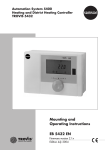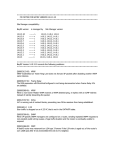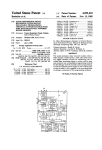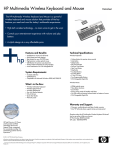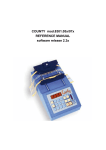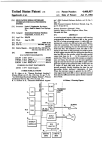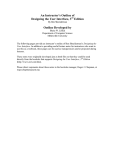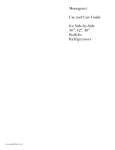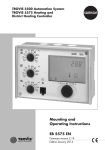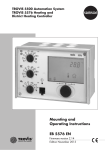Download Automatically adjustable delay function for timed typamatic
Transcript
United States Patent [19] Patent Number: Date of Patent: [11] [45] Johnson et 21. [54] AUTOMATICALLY ADJUSTABLE DELAY 4,490,055 Dec. 25, 1984 Printer", Balcezak et al., vol. 21, N0. 12, May 1979, pp. FUNCTION FOR TIMED TYPAMATIC 4759-4760. IBM Technical Disclosure Bulletin, “Multiple Repeat [75] Inventors: Carl F. Johnson; James M. Williams, [21] Appl. No.: 393,928 Rates for a Terminal Keyboard”, Leimer, v01. 23, No. 2, Jul. 1980, p. 770. IBM Technical Disclosure Bulletin, “I/O Keyboard Switching of Keys from a Typamatic to a Non-Typa matic Status", Motola, vol. 24, No. 11B, Apr. 1982, p. [22] Filed: MCS-48 Microcomputer User’s Manual, published both of Lexington, Ky. [73] Assignee: International Business Machines Corporation, Armonk, NY. 5859. Jun. 30, 1982 [51] Int. Cl.3 .............................................. .. B41J 5/28 [52] US. Cl. .................................... .. 400/51; 400/704; 1978 by Intel Corporation, pp. 1—l—2-15. Primary Examiner-Ernest T. Wright, Jr. 340/365 E [58] Field of Search ................... .. 400/50, 51, 52, 321, [56] 400/368, 369, 704, 70; 340/365 E, 365 S References Cited Attorney, Agent, or Firm—Laurence R. Letson [57] board utilizing a timed delay to determine whether a U.S. PATENT DOCUMENTS depressed key is indicative of the desire to print or 2,717,688 9/1955 Brooks .............................. ,. 400/704 $270,438 9/1966 Ephraim 3,436,735 4/1969 Hoiseth 3,618,034 11/1971 3,643,773 ..... . . . ,. display repetitive letters represented by that key. The typewriter is provided with a technique for automati cally adjusting the length of the delay such that a slow 400/704 X 400/368 X Hecker ...... .. 2/1972 Holmes, Jr. 3,781,874 12/1973 Jennings 400/51 X typist with sluggish ?nger movement will automatically 400/50 X cause the extension of the delay time and thereby pre vent unwanted repetitive characters while a fast, very rhythmic typist will not cause the automatic extension of the delay time and thereby will bene?t from a shorter delay time and will have a higher output or productiv 400/51 X 3,973,662 8/1976 Fulton .......... .. 4,106,011 4,189,246 8/1978 2/1980 Melanson et a1. ............ .. 340/365 E Kane et a1. ..................... .. 400/51 X 4,263,582 4/1981 Dumbovic .. 4,323,888 4/1982 Cole .............................. .. 400/368 X .. 400/50 X .... .. 340/365 5 ity as a result thereof. The automatic extension is accomplished by timing the period of time that keylevers are held depressed and FOREIGN PATENT DOCUMENTS 1411549 10/1975 ABSTRACT A typewriter is described which has an electronic key when that time approaches but does not exceed the preset automatic delay time, the delay time is then ex United Kingdom ................ ., 400/51 OTHER PUBLICATIONS IBM Technical Disclosure Bulletin, “Variable Time tended a predetermined amount. Delay for Hammer Firing in Rotating Disk-Type 11 Claims, 3 Drawing Figures NC SE'J‘JENTIAL llliEili'OGAllOk 0‘ EACH IEY PQSIIION Vii 1 \ IVPAMAYIB 11H? ‘ 1 (Mill ELAPSEZ ‘ an . DELAY NEEUED 1 1, moors 5 KEY TRANSITION OUTPUT 10 RITER ,1 TERMINAL PROCESSOR " ‘22 US. Patent Dec. 25, 1984 Sheet 1 of 3 TYPEWRITER/PRINTER +___ KEYBOARD PROCESSOR —> PROCESSOR 4,490,055 US. Patent Dec. 25, 1984 Sheet 2 0f 3 4,490,055 FIG. 2 I00 INITTALIZATION RoIITIME -/ T I02 OTHER KEYBOARD ROUTINE / u ‘ ———_.0 < TYPAMATIc ROUT'NE TYPAMATIc FLAG SET ?(FO) YES 404 -/ I34 NO SEQUENTIAL INTERROGATION OF EACH KEY POSITION ,Ios 430 CURRENT TYPAMATIC KEY RELEASED? DEPRESSED / RELEASED? , “0 CHECK TIMER FLAG;FI / IF TIMER IS RUNNING- “6 AYES REsET TYPAMATIC FLAG(FO) I24 432/ STOP T'MER - 426 sToP TIMER v sTART TIMER H8/ CHECK TIMER FLAG; Fl IF TIMER IS RUNNING _ sToP TIMER / I20 CHECK ELAPSED 428 - / DELAY TIME; CHANGE DELAY VALUE IT NEEDED PRocEss KEY TRANSITION OUTPUT TO TYPEWRITER / TERMINAL PROCESSOR -/ I22 US. Patent Dec. 25, 1984 Sheet30f3 4,490,055 FIG. 3 TIMER INTERRUPT 202 ADD 0?- JUMP TO COUNT / ___________________________ _ TOLWTFR ROUTINE DECREMENT TIMER OVERFLOW COUNTER. CHECK FOR ZERO. 204 _ / T IS OVERFLOW COUNTER ZERO? LOAD ZEROS / 208 INTO TIMER / STORE CURRENT ADDRESS T SET TYPAMATIC FLAG FO ,i )246 STOP COUNTER. RESET TIMER FLAG. Fl T l RETURN 210 1 4,490,055 2 Inasmuch as the operator or typist is unique in their timing, rhythm, speed and the length of time that a key AUTOMATICALLY ADJUSTABLE DELAY FUNCTION FOR TIMED TYPAMATIC BACKGROUND OF THE INVENTION is held depressed, it is not possible to provide a single timed delay which is acceptable or optimal for a great 5 With the advent of electronic keyboards on terminals and typewriters, there has been a need for improving OBJECTS OF THE INVENTION It is an object of this invention to adjust the delay and to lengthen the delay between the time a typamatic key is sensed as being depressed and the time that repetitive cycles are initiated under machine control. It is another object of this invention to reduce errone the operation of those keyboards to accomplish repeat characters. On mechanical keyboards which have the typamatic or repeat character capability, by holding the keybutton depressed to a second force level, the ma chine will repeatedly cycle and print repetitively the character indicated by the keybutton. ous typewriter inputs by sensing the typamatic keys and sensing the speed by which the keys are released and However, with keyboards using electrical or elec based thereon, adjusting the delay period. tronic contacts or a change in capacitance to indicate It is still another object of the invention to increase the depression of a keybutton for character selection, it is preferable to utilize an alternate technique of selecting repeated characters from the second depression force level approach. With electronic keyboards, whether they be capaci typing accuracy on timed typamatic keyboards for slower typists by providing a longer period within which they may react to release a keybutton. 20 tance or switch arrangements, all the positions on the keyboard are scanned or sequentially queried to deter cessor which controls the scanning and other organiza tional functions of the keyboard, will detect the held down condition and repeat the character automatically. This approach, although having many advantages, re quires a timed delay after the depression of the keybut ton before a second and subsequent cycles are initiated to insure that the typist has had an opportunity to re move the ?nger from the button and thereby not inad vertently initiate detection of the made or depressed SUMMARY OF THE INVENTION Electronic typewriters typically have keyboards which may be electronic in nature. If an electronic mine whether a keybutton has been depressed to select the character. One technique for repeating a character is the depression and release and redepression of the desired key. This approach will produce a plurality of identically repeated characters. For keyboards having the repeat character character istic, the keybutton may be held depressed and the pro majority of the operators. keyboard is implemented on a typewriter or, for that matter, an electronic data processing terminal, the key board is controlled by a processor which accepts signals from the keyboard responsive to a scan routine. The scanning of the keyboard is a technique for sequentially addressing each of keybutton positions and determining 30 whether a circuit is complete through that keybutton position to indicate the operator having depressed the keybutton. In addition to the scanning or sequential interrogation of each key position to determine a change in the state of the switching device utilized, the keyboard processor is capable of performing timing functions. The keyboard processor can time the period condition indicating repetitive characters. This may be accomplished by requiring a timed delay of 500 or 600 milliseconds from the time that the ?rst keybutton clos that a particular selected keybutton or a group of key buttons are held depressed. For example, a single keybutton such as the space bar may be timed for each depression of the space bar or the keybuttons which are designated as typamatic or repeat character keys may be timed whenever any one of them ing is sensed. If, after the predetermined delay time, the is held depressed. If a typamatic key is held depressed key is determined to be still held in a depressed condi for a period which is within 100 milliseconds of the tion, the processor assumes that repetitive characters 45 preselected delay time, the keyboard processor auto are to be printed and initiates the appropriate printing matically resets the delay time value to a next higher cycles to form those characters on the record media, delay time unless the delay time is already at the maxi typically at machine cycle speed and continuing until mum preselected value. such time as the keybutton is released and the keyboard If the keybutton is still depressed and the switching processor detects the change of condition from a de 50 element in the keyboard indicates that the circuit is pressed key to a released key. made for that particular keybutton at the end of the Typewriters and data processing terminals utilizing electronic keyboards and which are presently in the market utilize a ?xed time delay, typically 600 millisec onds. This 600 millisecond delay is too long a period for a fast typist since a fast typist can typically key charac ters at an average rate of one character every 200 milli‘ timed delay period and that keybutton represents a typamatic character, the keyboard processor detects this condition and begins to repetitively output the character signal to the main typewriter or printer pro cessor to cause the printing of that character at the printer machine rate. seconds or less. The net result of the 600 millisecond Further, the adjustment of the delay time is supressed delay period is that a fast typist has their typing rhythm interrupted by virtue of having to stop and wait an inasmuch as it is clear at the end of the delay period that 60 the reason for continued depression of the key was to additional 300-400 milliseconds for the repeat mode to cause typamatic printing. begin to be initiated. Release of the typamatic key prior to the end of the A shorter time delay is undesirable from the stand delay period will prevent any repeating characters. point that a slow or sluggish typist will allow the ?ngers Additionally, the depression of any other key on the to rest on the keyboard keys and may inadvertently 65 keyboard will be detected notwithstanding the contin leave the key depressed for such a period of time as is ued depression of the typamatic key, and the depression necessary to initiate the repetitive printing or typamatic of this other key during the time delay period will indi printing of a character. cate a desire to subsequently print a second character 3 4,490,055 4 and not enter the repeat mode and therefore will defeat of the depression of a selected typamatic key to initiate the entry into the repeat mode notwithstanding the subsequent printing cycles. continued depression of the typamatic key. Printing cycle is used in the conventional term associ ated with typewriters, but it should be recognized that ‘ If the typamatic mode of operation is entered after the time delay period, there will be no change in the the displaying of a character on a display by means of delay time inasmuch as the long period of depression of illumination and electronic character generation may . a typamatic key is due to the desire for repetitive typing also be included within the terminology of printing. Referring to FIG. 1, the typewriter 10 has a keyboard 12 associated therewith. In addition, typewriter 10 also rather than due to sluggish typist action or slow re moval of the ?nger from a typamatic key. has a printing assembly 14 capable of physically mark-i DRAWING ing a record sheet 15 to display characters by any con ventional typing or printing technology and the specif- , FIG. 1 illustrates a generalized system wherein a keyboard processor controls and receives signals from 1 the keyboard and provides those signals to a main pro cessor which, in turn, provides signals to the keyboard processor, to the printer and receives feedback signals from the printer. FIG. 2 is a How diagram illustrating the flow of oper ations for carrying out the automated adjustment of the delay time for a timed typamatic keyboard. FIG. 3 is a flow diagram illustrating the flow within the timer interrupt routine. ics of that portion of the device do not constitute part of ‘ ' the invention described herein. Keyboard‘processor 16 i‘ 5 is the Intel 8048 microprocessor described above and is electronically connected to and interfaced with data lines leading to and from keyboard 12. The techniques of attaching these data lines to the keyboard processor 16 and the particular arrangementof keyboard 12 are 20 conventional and do not constitute any portion’ of the invention. ' Keyboard processor 16 is electronically interfaced , with the typewriter/printer processor 18 hereinafter DESCRIPTION OF THE INVENTION referred to as the printer processor 18. The printer For purposes of implementation and for purposes of 25 processor 18 performs all the necessarycontrol func- '_ describing this invention, a microprocessor sold under the designation Intel 8048 microprocessor sold by the Intel Corporation of Santa Clara, Calif., is used as the control of the electronic keyboard 12. Hereafter, the Intel 8048 microprocessor will be referredras the key 30 board processor 16. The Intel 8048 microprocessor is readily commer tions and determinations for operating the printing as» . sembly 14 of the typewriter 10 to cause the printing of , ‘ characters. Printer processor 18 sends control signals to t the printing assembly 14 and receives vthe necessary feedback signals from the printing assembly 14 to main- ' tain control of the printing ‘assembly ‘14 in an appropri4 ate sequence. Printer processor 18 receives character‘ cially available and the Intel Corporation provides man uals on its use indicating available register designations, available ?ags and their designations, and a list of in signals and other necessary control signals from the keyboard processor 16 and provides feedback to key-l 7 board processor 16. The keyboard processor 16 likewise struction codes which may be utilized to cause the pro has two-way connections to the keyboard 12 to provide 1 cessor to function. signals to the keyboard 12 for purposes of scanning the Additionally, the Intel 8048 has an eight bit timer keyboard 12 and a return path for signals from the key-' which counts in response to clock pulses generated by button switching elements 11 in keyboard 12 such that the timing clock of the microprocessor 16 and will run 40 the signals generated thereby may be transmittedtto the through a complete 256 count timing sequence and keyboard processor 16. overflow every 20.48 milliseconds (Msec). Referring to FIG. 2, the initialization routine in‘ block ~ " The Intel 8048 processor, in addition to being readily 100 accomplishes the loading of preset information into; available in the marketplace, is a conventional piece of designated registers R0. R3-R7 within the processor 16 electronic equipment widely used in many applications. 45 when the processor 16 and typewriter 10 are initially The architecture and operation of the Intel 8048 pro turned on. This information is permanently stored "in ; cessor is described in the MCS-48 Microcomputer non-volatile read only memory locations within the ‘ User’s Manual, Copyright 1978, Intel Corporation, keyboard processor 16 and is not changeable type of pages l-l through 2-16, which are incorporated herein by reference. information. 50 The Intel 8048 processor includes within its structure at least a clock, timer/event counter, registers, memory I ‘ The information loaded into the respective registers ‘ with their initial values are set forth below by wayof illustration and not by way of limitation. locations, read-only-memory and flags F0 and F1. ‘ These elements of the Intel 8048 processor are utilized to control the monitoring and altering of the timed delay of the typamatic function as it is more completely described below. Appendix A attached is a listing of instructions, state ments and instruction codes and addresses which will control the keyboard processor 16 to perform the rou 60 tines described in the flow diagram of FIG. 2. Description of or Information Contained Register Designation RO in the Register Pointer to cause the addressing of selected registers R20—R29 R2 Timer over?ow count ' While this system is described in connection with a R3 R4 Fractional delay value Whole portion current typewriter 10, and utilizes the input from the typewriter R5 Fractional portion current delay value keyboard 12, it should be recognized that this same typamatic adjustment of the delay may be implemented delay value R7 Status Register on any system which utilizes an electronic keyboard R20 9 and which has typamatic keys and where the processor responds to a timed delay period after the ?rst detection R23 90 65 ' ' » ‘ ‘ . j ' 4,490,055 5 -continued Description of or Information Contained Register Designation in the Register R24 R25 R26 R27 R28 R29 6 After the initialization routine is accomplished (block 100), other keyboard routines not germaine to this in vention are performed by the keyboard microprocessor 16 (block 102) and, by way of illustration, include the checking of the code key 13 on a typewriter keyboard 12 to determine whether it has been depressed signaling 19 120 24 151 29 180 a command other than a character selection when com bined with a character key depression. Additionally. a check of the printer feedback signal from the printer processor 18 may be made at this time to maintain the keyboard processor 16 in synchronization with the printer processor 18 and the printer assembly 14. With the initializing of the registers R0-R29 as indi cated herein, the timing delays are stored such that they are accessible by the processor 16 not in terms of actual time delay but, rather, in terms of complete timer cycles which require 20.48 Msec per timer cycle. The tabula tion below indicates a time period delay and the number pa 5 The flow then proceeds to block 104 wherein a deci sion is made as to whether the typamatic ?ag F0 is set. Initially, the typamatic flag F0 has been initialized in the initialization routine in block 100 in an unset condition and, therefore, the flow proceeds through the “No" of whole timer cycles and a value which, when loaded path to the sequential interrogation of key position sub into the timer, will result in a fractional timer cycle very routine in block 106. In electronic keyboards, the key closely approximating the desired time and which cor 20 board processor 16 sequentially addresses the matrix of relate to the initialization values of registers R20-R29 keyboard switching elements 11 to determine which, if above. any, have been caused to create a transition from a make to a break or from a break to a make condition. As a 200 300 400 500 600 Msec Msec Msec Msec Msec Whole Cycles Fractional Cycle 9 14 19 24 29 ll 61 90 120 151 180 result of this sequential interrogation, the ?ow proceeds to block 108 wherein a decision is made as to whether a key transition from a break to a make or make to a break has occurred in the keyboard 12. If no transition has occurred, then the flow returns by the path indicated and reenters the decision block 104 to determine whether the typamatic flag has been set. This loop con The timer is a 256 cycle or an eight bit timer which operates on the 80 microsecond clock pulse period thus resulting in a complete timer cycle from O to 256 in 20.48 milliseconds. Thus, to get a 200 millisecond delay will require a total of nine complete timer cycles and 0.76 fractional timer cycle. In order to operate the timer within its operational constraints, an initial fractional value is loaded into the timer from which the timer will then count upward to its capacity of 256. Thus, a value loaded into the timer cycle is the portion of the timer cycle not required and, thus, represents a starting point for the timer to count upwardly from. To determine the fractional amount to be loaded into the timer, the equa tinues until such time as a key transition has been de tected and such a decision has been made that a transi tion occurred in decision block 108. Upon the detecting of a key transition, the flow pro ceeds from block 108 to block 110 wherein the typa matic question is posed “Has the typamatic flag been set?” If the typamatic flag F0 has not been set, the pro cessor flow proceeds through the no path to decision block 112 which determines whether the key transition determined in block 108 was a depression or a release. If the transition was a depression of the key, then the path goes to the decision block 114 where the determination is made as to whether the key which ransitioned was a tion [20.48—0.76(20.48)]/0.08=61 is illustrative of how 45 typamatic key such as a period 19 or space 21 key and the fractional value for a 200 millisecond time delay is if the key was a typamatic key 19, 21 then the flow path determined. The 20.48 is representative of the time goes by the yes route to check the timer ?ag F1 and if required for a complete timer cycle and 0.76 represents the timer is running, to stop the timer ‘as indicated in the fractional portion of a timer cycle required in addi subroutine block 116. This condition is a condition tion to the complete timer cycle for the desired time 50 which may exist if the typamatic key 19, 21 just de delay. pressed was the second consecutive typamatic key 19, Similar calculations may be performed to arrive at the whole or fractional number values for the registers R20 and R29 for each of the predetermined time delays. For each of the predetermined time delays, two regis 55 ters have been dedicated to storing the numbers and, thus, they are available to the processor 16 to update the time delay when appropriate. Again, referring to FIG. 2, after the initialization procedure and the initializing of the typamatic flag F0 21. - Upon the completion of stopping the timer, it will have the effect of initializing the timer and the timer is then restarted in block 118. By stopping the timer and restarting the timer, this insures that the time delay period being considered is applicable only to the most recent typamatic key 19, 21 and effectively removes the possibility of inadvertently typing repeat characters and timer flag F 1 to an unset condition, the sequence of from a former typamatic key 19, 21 when it is clear by the depression of a subsequent key that the operator events portrayed by the flow diagram may proceed. It should be noted that flag F0 and F1 are arbitrary ?ags earlier key depression. does not desire to enter the typamatic mode on the which may be used and their use is available to the Returning to decision block 114, if the determination designer for any purpose desired and may be set and 65 is that the key transition was a depression and that it was reset as desired under instruction control. These flags not a typamatic key 19, 21, then if the timer flag F1 is set F0, F1 are provided in the Intel 8048 used as the key and thus the timer is running, the timer is stopped as board processor 16. indicated in block 120. This insures that any previous 7 4,490,05 5 typamatic key 19, 21 which remains depressed does not trigger subsequent repeat characters. Upon the completion of either the restarting of the timer in block 118 or the stopping of the timer in block 120, the key transition is processed and an output is generated to the typewriter printer processor 18 to accomplish printing of the selected character in accor dance with the other keyboard routines and the flow returns from the key transition processing block 122 8 typamatic key address, then ‘the flow follows the YES path to block 132. routine Referring is illustrated. to FIG. For 3, the best ?ow understanding, ofthe. timer the interrupt timer , ‘ I portion of the processor l6continues to operate simul taneous with other functions of the processor 16 per-, forming the flow illustrated in FIG. 2. Every time the timer of the processor 16 reaches a condition where all" bits are , that is indicated as an overflow condition 10 and a timer interrupt signal emits from that portion of ' back to enter block 104 for the next cycle. the processor 16 to interrupt the sequence of operations Referring back now to decision block 112 where the in the flow of FIG. 2. As dictated by the construction of a determination was made asto whether a key transition the Intel 8048 processor, utilized as the keyboard pro with no typamatic ?ag F0 set was a depression or a cessor 16, any time there is a timer overflow condition I release and where the decision was that the transition was a release, the determination is then made as to whether the key 17, 19, 21 released was a typamatic key in decision block 124. The purpose of this is to accom modate the stopping of the timer upon the release of the key (Block 126). If the key 17, 19, 21 was a typamatic key, then the stop timer routine (block 126) is the next function of the processor 16 and the time elapsed determined in block 128. If the time elapsed is within approximately 100 milliseconds of the current delay time, then the subrou initiating a timer interrupt command, the processor 16 immediately goes to address 07 whichis a jump to count routine instruction. This is‘ illustrated at block202'. From the jump to count instruction stored in address 07 (block 202), the count routine is entered to effect the counting in register R2 for keeping track of thettime delay. Upon the receipt of a timer interrupt command and the processing of the jump to count instruction , (block 202), the timer over?ow count (register R2) is ‘ decremented by one and a check to see if the timer 25 over?ow count is now zero (block 204). tine represented by block 128 will change the delay If the over?ow counter contents is not zero, then the value to the next larger predetermined delay value as represented in registers R22-R29. The check of the time is effectively accomplished by checking the value in flow follows the NO path from block ‘206 where that‘ decision is made to block 208 where a routine directs that zeros are loaded into the timer. As soon as the zeros . ‘ ' register R2 and comparing it with a preset numerical 30 are loaded into the timer as commanded by subroutine I value of 5. If it is equal to or less than 5, the typamatic indicated at block 208, the timer will immediately begin . 19, 21 key has been held down to within approximately counting in response to the timing pulses ‘of the key 100 milliseconds of the current delay time and the sub board processor clock. ’ routine will make the desired change in the delay time Thereupon, the flow goes to return block 210. Upon. value. 35 entering the return routine (block 210), the processor 16 After the completion of making such a change, the returns to the flow in FIG. 2 at precisely the point it was key transition is processed and in this case would not when the interrupt command was issued by. the timer. initiate a character. The key transition processing is The flow of FIG. 2 then continues uninterrupted .until ; accomplished in block 122. such time as a subsequent timer interrupt. command Referring back to the decision in block 124 as to whether the released key 17, 19, 21 was a typamatic key and with a "NO” response to that determination, then the next step is the processing of key transition 122. Returning to decision block 110 wherein a determina tion is made upon a key transition as to whether the typamatic flag F0 has been set and where the flag F0 has been set, the decisional ?ow will be to decision block 130 where a determination is made as to whether the current typamatic key 19, 21 has been released. In the event that the current typamatic key 19, 21 has not been released, the flow returns to reenter block 104. In the event that the current typamatic key 19, 21 has been issues upon a timer overflow condition. Referring back to block 206, if the over?ow counter contains a zero after the decrementing in block 204, the YES path is followed and the current address of thekey position which has been held depressed throughout'the entire period of time that the timer was overflowing a suf?cient number of times todecrement the timer over~ flow counter to zero, is stored (block 212). This address will be utilized by the main flow in FIG. 2, speci?cally block 130, during a check routine to determine subse quently when that typamatic key 19, 21 is released. After the storage of the typamatic ‘key address (block , ~ 212), the typamatic ?ag F0 is then set (block 214) and released (block 130), then the typamatic flag F0 is reset the counter is stopped. This effectively prevents'the. ‘ by the subroutine represented by block 132 and then the timer from continuing to time‘ inasmuch as there is no key transition is processed by block 122. 55 need to do so until either the typamatic key 19, 21‘ has. I In decision block 130, there is a check procedure been released or another typamatic key 19, 21 has been performed to determine whether the current typamatic depressed. This operation is represented by block.216.' key 19, 21 has been released. This check compares the At the same time, the timer flag F1 is reset to a zero I last key transition address or the key location designa condition indicating that the timer is not functioning. At * . tion on the keyboard 12 which last indicated a key transition with the current typamatic key address to determine if the current typamatic key 19, 21 was the one released. If the transition indicated as a release is this point, the flow goes to return (block 210) wherein ' the main flow of FIG. 2 is reentered at‘the ‘precise point that the timer interrupt occurred‘and the process illus trated by the flow diagram in FIG. 2 continues uninter- ‘ not the current typamatic key 19, 21, then there is con rupted until interrupted by another interrupt command. . i‘ tinued scanning of the keyboard 12 by reentering at a 65 The rectangular blocks in the above routine represent point upstream from block 104. When the current typa subroutines which are performed under a series of t in matic key is released (Block 130) and there is a compare structions contained in theread-only-storage portion of between the last key transition address and the current processor 16. The sequential interrogation of each key 4,490,055 position in block 106, the other keyboard routines in block 102 and the processing of the key transition 122 10 APPENDIX A-continued have not been listed in Appendix A inasmuch as they are conventional routines which can be found in elec tronic keyboards presently on the market, for example, in the IBM 6240 keyboad manufactured and sold by the International Business Machines Corporation, Armonk, NY. The routines enumerated in Appendix A involve LO' CATION PRO GRAM CODE 7 04 LA BEL NMEMONICS COMMENTS Jmp Count Timer Interrupt Pointer some aspect or signi?cantly add to the understanding of 1O the invention herein and, therefore, are included. Appendix A has a code listing of instructions set forth 8 9 A B C using conventional notation and is grasped into five D 9A [Following is part of an initialization routine] E F columns, Location, Program Code, Label, Nmemonics and Comments. The routine in block 134 is the routine which controls the output of characters in the repeat mode. It checks the printer feedback signals to determine when the printer is ready for the next character. 10 05 ENI Enable Timer ll 85 CLR F0 Reset Interrupt Typamatic Flag 12 The sequential interrogation (block 106) is a routine which is dictated by the type of keyboard used, such as A5 CLR F 1 conductive, capacitive or membrane. In conjunction with the interrogation controls, a register is used to store indicators of status in bits 0, 1 13 B8 14 Z0 l5 14 Mov R0, H20 Initialize Pointer Call load Places delay current delay value in R4 and R5 and 2 and are designated: Bit 0—-typamatic bit, l-typamatic, 0 not typamatic Bit 1—key transition bit, l-transition, 0 no transition Bit 2—-key depressed/released, l-depressed, 0 released The interrogation routine determines (I) if the key position is typamatic and sets bit 0, (2) if the key 17, 19, 25 16 keyboard 12. Speci?c examples of these routines will not aid in 60 19 [Other keyboard routines located here] 1A 21 is up or down, (3) if key transition has occurred and sets bit 1, and (4) if the key 17, 19, 21 has been released or depressed (bit 2). The processing of the key transition (block 122) controls output of data to the printer/type writer processor 18 and controls the scanning of the ID 7. B6 Pl JFOP0 By adjusting the time delay through which an opera tor must hold a typamatic key 19, 21 depressed in order to get repetitive character printing, the slow typist will Flag is Set 21 24 22 04 23 26 24 14 25 — Jmp P2 P0 Call Typamatic P2 Call Interrogate 26 14 27 — automatically with a minimum of errors, cause the ad 28 FF Mov A, R7 justment of the time delay typically within three or four typamatic key cycles, to a value which will insure that the typamatic characters are only printed when desired 29 32 J81, P3 key transition 28 04 Jmp, Pl beginning 2C 20 2D 12 2E 31 2F 04 30 3l 36 14 A typist with a fast and very rhythmic stroke will not 32 - adjust the time delay as rapidly and therefore will be able to avail the typist of a shorter delay time for any 33 95 intentional typamatic characters. 34 04 35 52 36 52 37 4O 38 12 typically typamatic keys with a relatively high degree P3 IEO, P4 mode keybutton will, of necessity, condition the typewriter 10 within a very, very few keystrokes on either of these keys 19, 21 to extend the delay time. Jmp, P5 P4 Call check CPL F0 0 l 2 3 4 5 6 Reset typamatic ?ag Jmp, P6 APPENDIXA NMEMONICS Jump if in typamatic of usage. Thus, a slow typist who tends to linger on the LA BEL No transition, go to the typewriter 10 is turned on and typing commences inasmuch as the spacebar 21 and period key 19 are both PRO GRAM CODE Get Index or Register Check for 45 keystroke. This adjustment will occur very rapidly after LOCATlON Jump if Typamatic 35 understanding the invention and are not part thereof. and which will also accommodate a slow or sluggish Reset Timer Flag Jump to Process key transition P5 JB2, P7 Jump if key depressed COMMENTS 65 39 3C 3A 04 3B 52 J90, P8 Jump if key is typamatic Jmp, P6 Jump to Process key Transition 4,490,055 111 112 APPENDIX A-continued r LO- PRO- CA- GRAM LA~ TION CODE BEL NMEMONICS P8 Call stop timer 3C 3D 3E 14 89 04 Jmp, P6 ' APPENDIX A-continued LO- PRO CA‘ GRAM LA~ TION CODE BEL NMEMONICS COMMENTS 1 79 7A FC sum Mov A, R4‘ a Move whole Jump iftimer 713 AA Mov R2’ A "“m‘mg 7c FD Mov A, R5 7D AB Mov R3, A‘ 7E 62 Mov T, A Load fractional Start T ‘ 5211:: into sum timer‘ COMMENTS 5 Jump to 73 74 75 Process key 76 1 Transition 3F 52 40 12 Jmp, P9 41 4A 42 04 JFl, P10 43 46 I 44 a4 Jmp, P6 I Timer t Transitions 52 g; 48 04 value to ‘R2 ' v Move fractional ' i Jump to 15 “W955. key 45 is value t0lR3 a ‘ t t PM can mp “me” Jmp, P6 ‘ 73 ‘ Jump‘if key *5 typamatlc ‘ ' 77 10 P7 ‘ Jump to 7F ‘ 55 82 , 20 FI Process key , , S64 “mar ‘?ag ’ Transitions 49 4A 52 04 43 4E 4c 04 4D 50 Jmp, P11 33 84 Jump if timer ‘ running 85 25 Jmp, P12 86 ‘ 87 88 ‘ 4E 14 4]: 39 50 51 14 7A P12 Call Start timer 52 14 P6 Call Process remaining Key Transition time less 53 — 54 04 55 20 p11 can Stop timer ‘ 30 89 65 Stop Stop tent ‘ Stop timer 8A ‘ B5‘ timer Cpl Fl 88 FA Reset timer, 7 ?ag ‘ Check if ~ Mov A, R2 Jmp, Pl Jump to beginning BC‘ 8D ‘ 56 35 37 03 8E 05 8F‘ F6 Cpl A Add A, H05 k ‘ JC, increase 57 delay 58 timeless than ' v 100 msec 5A 90 5B 91 1 5C 40 6A‘ A s3 [)3 ‘ 5E 94 5F ‘ F0 Load Mov A@R0 Delay 95 Gets delay values using pointer and 96 ‘ , 97 ‘ 45 98 puts them in 99 R4 and R5. 62 7 RET» 92 5D 61 Jump'iF carry Y ' set (remaining ‘ 59 60 I than 100 msec AC , Mov R4.A 9A 18 1NCRO 9B 63 F0 Mov A@R0 9c 64 AD Mov RS’A 65 33 EA 1 2325 1R2’ A5 ‘ If I Ret 50 eserved or, 9D 66 code to store 9E I ‘ current key, (,7 68 9F 69 A0 95 Cpl F0 Sets typamatic‘ Al A2 65 B5 Stop tent Cpl Fl Stop timer Reset timeri 6A address. FC In- Mov A, R4 Crease dry’ If stop timer routine indicates that a ?ag 55 new delay value ' is needed, this A3 routine will A4 A7 ‘ A5 27 Count increment Ra pointer‘and call load delay. A6 62 A7 93 XRLA, H29 6D C6 .12, Delay 1 6E 72 6F 18 INC R0 14 Call'load delay‘ AB RET AC AD 72 A8 1 Delay 65 A9‘ ‘ AA ?ag ~ ‘ Imp’ Count 3 ~ 1 D3 29 60 83 m4 60 ‘ 6B 6C 70 71 ‘ ‘ Clr A t MOV T, A Count 2‘ Load zeros 11110 lime!‘ RETR‘ 4,490,055 13 APPENDIX A-continued 1.0CA- PR0 GRAM TION CODE LA BEL 14 insufficiently long to cause said repetitive charac ter display or function operation. 4. The method of claim 3 wherein said adjusting com NMEMONICS prises: COMMENTS providing a plurality of selected time periods and selecting the next larger of said time periods and substituting said next larger of said time periods for said ?rst predetermined time period. 5. A character displaying apparatus having a key AF We claim: 1. A method of controlling the sensing time period for detecting a condition indicative of a desire for a charac board capable of at least some repetitive character and function selection through key depression for a pro ter to be repetitively displayed comprising: providing a preset sensing time period, the exceeding of which by the depression of a single character key is indicative of a repetitive display operation; measuring the period of time that a selected control longed period of time comprising: means for detecting key depression and release, means for timing the period between key depression and key release, means for comparing said period with said prolonged key is depressed; period, comparing said period of time with a predetermined standard time period; means for initiating repetitive character or function increasing said sensing time period when said period of time exceeds said standard time period, whereby an operator who is slow and holds keys depressed for a longer period of time than normal will not 20 period is within a predetermined amount of time of undesirably display multiple characters. said prolonged period, thereby automatically sens ing a sluggish typist and increasing the prolonged 2. The method of claim 1 wherein increasing said sensing time period comprises selecting one of a plural selection when said period exceeds said prolonged period, and means for increasing said prolonged period when said 25 ity of varying sized sensing time periods. period a key must be held depressed to cause repet pressed to initiate repetitive character display or func itive character or function selection. 6. The apparatus of claim 5 wherein said means for increasing comprises a timer over?ow counter and means for selecting predetermined values for use in said tion operation comprising: timer over?ow counter. 3. The method of controllably changing the time period a key of a keyboard must be maintained de providing a keyboard capable of electronically sens 7. The apparatus of claim 5 wherein said means for ing key depression; timing comprises a timer counter of ?xed capacity which overflows when counted to capacity, and said providing a ?rst predetermined time period; means for comparing comprises a timer over?ow determining the period of time a key on said keyboard 35 counter for accounting for timer over?ow events. is depressed; 8. The apparatus of claim 5 wherein said means for determining if said period of time is less than but timing is operatively associated with selected keys on within a predetermined amount of said predeter said keyboard. mined time period, and if within said predeter 9. The apparatus of claim 8 wherein said selected keys mined amount; comprise a space key and a period key. adjusting said predetermined time period to a longer 10. The apparatus of claim 5 wherein said apparatus predetermined time period, thereby lengthening having said keyboard is a typewriter. the time period a key must be held depressed to 11. The apparatus of claim 5 wherein said repetitive initiate repetitive character display or function character selection comprises repetitive printing of said operation when a key is held depressed, a period approaching said predetermined time period but 45 character. it 50 55 65 it i it i











